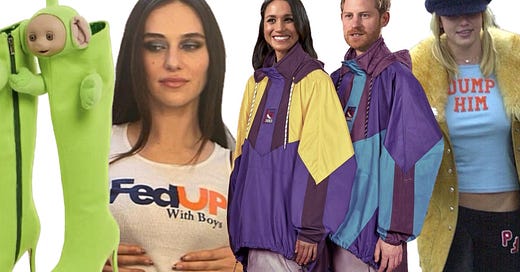Fashion has always been an industry that thrives off of shock and hype. It’s wild, it’s funny, it’s ironic, and at times it’s a little chaotic. It’s an industry that grabs people by the eyeballs and keeps them guessing, and at times it leaves people wondering what the hell were you thinking.
As fashion has been engineered into entertainment, with runway shows, divisive campaigns and satirical designs becoming a spectacle in and of themselves, they’ve morphed into visual gags and memorable cultural moments. You know, when Coperni did the spray-on dress on Bella Hadid for their SS23 show at PFW industry insiders couldn’t stop talking about it, and when Kim Kardashian wore Marilyn Monroe’s dress to the Met Gala it was, well, the hot topic on everyone’s lips to say the least.
So now, loud fashion over quiet fashion, sensational fashion over the mundane, and controversial outward-facing fashion is what people are lapping up. And because it’s this kind of fashion that the algorithm seems to favour allowing it to take centre stage, fashion brands are entering the age of content 2.0 - but have they created an entertainment problem in the process?
It’s widely known that social media has changed our relationship with fashion. Especially as our exposure to socials increases and our adoption of tech cements us in the digital age, brands are exploiting social media to ensure that they remain top of mind. Cult-like followings are now widely desired and shareable moments have become the norm, making light of the industry's more entertaining side.
This viral, pop-culture led entertaining aspect of fashion doesn’t come without its share of controversy. After being the it brand of the past few years, Balenciaga’s diabolical 2022 ad campaign forced creative director Demna to take a step back and reassess. In the notes accompanying the brand's most recent FW23 show, Demna explained how “fashion has become a kind of entertainment,” and this new collection would focus on “the art of making clothes.”
Now, designers have always wanted to create viral fashion moments, and they will continue to do so for better or worse, at times much to their detriment. It’s this unorthodox approach that's turning fashion into a content machine. Entertaining, meme-worthy fashion creates a moment to remember, piques people's interest and sets the internet ablaze, leading to a fashionable era that is as wearable as it is shareable.
Emma Chamberlain wore a tank top in Bora Bora that read “Niche Internet Micro Celebrity” which fits the fashion content mould perfectly, reminiscent of Britney Spears donning the iconic “Dump Him" shirt in the 2000s. And Instagram accounts such as @siduations and @freddiemade use meme-worthy content to showcase how irony and humour are resonating with fashion lovers of today.
As fashion gets pulled into the viral content ecosystem it has become a novelty to enjoy. Fashion month may be a circus, and clothes may now be meme-able rather than valuable physically, but in a way, it’s so that fashion can be viewed through a wider audience lens. Yes, entertaining and social-first fashion is the moment. But at least now we’re a part of the conversation rather than passive bystanders, and that's got to be a good thing right?
Share this post, feel free to comment, and subscribe to Fashion Tingz to keep the conversation going.






